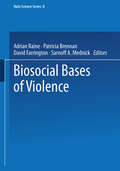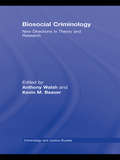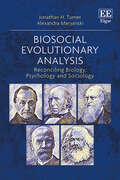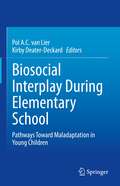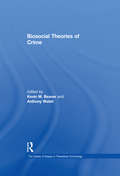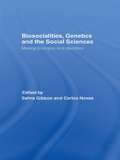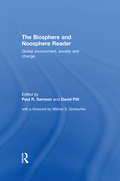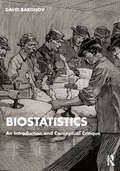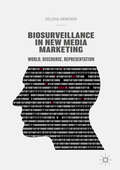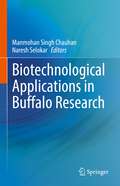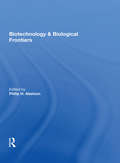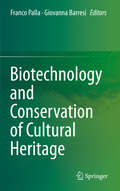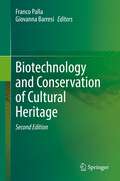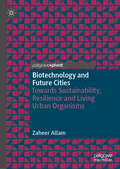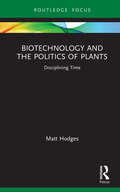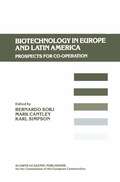- Table View
- List View
Biosocial Bases of Violence (Nato Science Series A: #292)
by Adrian Raine Patricia Brennan David P. Farrington Sarnoff A. MednickProceedings of a NATO ASI held in Rhodes, Greece, May 12-21, 1996
Biosocial Criminology: New Directions in Theory and Research (Criminology and Justice Studies)
by Anthony Walsh Kevin M. BeaverIdeal for use, either as a second text in a standard criminology course, or for a discrete course on biosocial perspectives, this book of original chapters breaks new and important ground for ways today's criminologists need to think more broadly about the crime problem.
Biosocial Criminology: New Directions in Theory and Research (Criminology and Justice Studies)
by Anthony Walsh Kevin M. BeaverIdeal for use, either as a second text in a standard criminology course, or for a discrete course on biosocial perspectives, this book of original chapters breaks new and important ground for ways today's criminologists need to think more broadly about the crime problem.
Biosocial Evolutionary Analysis: Reconciling Biology, Psychology and Sociology
by Jonathan H. Turner Alexandra MaryanskiThis authoritative book proposes a methodological and theoretical strategy for developing sociological explanations of the socio-cultural universe. Jonathan H. Turner and Alexandra Maryanski discuss the problems that persist in explaining the socio-cultural universe using only biological and psychological approaches and outline new strategies for understanding the evolution of human beings and their biological nature.Through exploring human evolution, human nature, human behaviours and patterns of social organisation, Turner and Maryanski demonstrate that evolutionary explanations of behaviours and patterns can be drawn from modern synthesis in biology. They also explain why certain dimensions of the socio-cultural universe can only be understood using purely sociological approaches to evolutionary analysis. They expertly analyse alternative biologically-based strategies for explaining the evolution of human beings and a purely sociological strategy for understanding the emergent properties of human socio-cultural formations.Innovative in its approach, this timely book will be of great interest to scholars interested in the fields of science and technology studies, sociology and sociological theory, cultural sociology, social psychology, and social policy. It will also be highly beneficial to those looking to better understand the optimum methodological strategies for understanding the biology of human nature.
Biosocial Interplay During Elementary School: Pathways Toward Maladaptation in Young Children
by Pol A. C. van Lier Kirby Deater-DeckardThis book examines the effects of social relations during primary school on children’s neurobiology and pathways to maladaptation. It explores the ways in which after the transition to primary education children, supervised by teachers, need to function with their peers. The volume addresses issues affecting 10% to 20% of children who become poorly accepted or victimized by peers, receive low support by teachers or even have conflictual relations with teachers, and may perceive the classroom as a whole as nonsupportive. Key areas of coverage include:Detrimental effects of such social experiences, providing an overview of how such experiences affect children’s neurobiology factors to understand why these children develop maladaptive outcomes.Manifestations of social relations, their complexity, interrelations, and pathways leading to the maladaptive outcomes.How genetic factors may evoke children’s social environment and make them susceptible to its impact (e.g., findings on DNA methylation at both epigenome-wide level as well as on particular loci on candidate genes).Links between social environmental stressors and the psychophysiology of elementary school children and reviews both links with the autonomic nervous system as well as with the HPA-axis.The impact of social experiences on neurocognitive function development, decision making, and structural and functional brain development and discusses implications for research, prevention, and intervention. Biosocial Interplay During Elementary School is a must-have resource for researchers, professors, and graduate students as well as clinicians and other professionals in clinical child, school, and developmental psychology, educational psychology/policy and politics, social work, neuroscience, public health, and all related disciplines.
Biosocial Theories of Crime
by KevinM. BeaverBiosocial criminology is an emerging perspective that highlights the interdependence between genetic and environmental factors in the etiology of antisocial behaviors. However, given that biosocial criminology has only recently gained traction among criminologists, there has not been any attempt to compile some of the "classic" articles on this topic. Beaver and Walsh's edited volume addresses this gap in the literature by identifying some of the most influential biosocial criminological articles and including them in a single resource. The articles covered in this volume examine the connection between genetics and crime, evolutionary psychology and crime, and neuroscience and crime. This volume will be a valuable resource for anyone interested in understanding the causes of crime from a biosocial criminological perspective.
Biosocial Theories of Crime
by KevinM. BeaverBiosocial criminology is an emerging perspective that highlights the interdependence between genetic and environmental factors in the etiology of antisocial behaviors. However, given that biosocial criminology has only recently gained traction among criminologists, there has not been any attempt to compile some of the "classic" articles on this topic. Beaver and Walsh's edited volume addresses this gap in the literature by identifying some of the most influential biosocial criminological articles and including them in a single resource. The articles covered in this volume examine the connection between genetics and crime, evolutionary psychology and crime, and neuroscience and crime. This volume will be a valuable resource for anyone interested in understanding the causes of crime from a biosocial criminological perspective.
Biosocialities, Genetics and the Social Sciences: Making Biologies and Identities
by Sahra Gibbon Carlos NovasBiosocialities, Genetics and the Social Sciences explores the social, cultural and economic transformations that result from innovations in genomic knowledge and technology. This pioneering collection uses Paul Rabinow’s concept of biosociality to chart the shifts in social relations and ideas about nature, biology and identity brought about by developments in biomedicine. Based on new empirical research, it contains chapters on genomic research into embryonic stem cell therapy, breast cancer, autism, Parkinson’s and IVF treatment, as well as on the expectations and education surrounding genomic research. It covers four main themes: novel modes of identity and identification, such as genetic citizenship the role of institutions, ranging from disease advocacy organizations and voluntary organizations to the state the production of biological knowledge, novel life-forms, and technologies the generation of wealth and commercial interests in biology. Including an afterword by Paul Rabinow and case studies on the UK, US, Canada, Germany, India and Israel, this book is key reading for students and researchers of the new genetics and the social sciences – particularly medical sociologists, medical anthropologists and those involved with science and technology studies.
Biosocialities, Genetics and the Social Sciences: Making Biologies and Identities
by Sahra Gibbon Carlos NovasBiosocialities, Genetics and the Social Sciences explores the social, cultural and economic transformations that result from innovations in genomic knowledge and technology. This pioneering collection uses Paul Rabinow’s concept of biosociality to chart the shifts in social relations and ideas about nature, biology and identity brought about by developments in biomedicine. Based on new empirical research, it contains chapters on genomic research into embryonic stem cell therapy, breast cancer, autism, Parkinson’s and IVF treatment, as well as on the expectations and education surrounding genomic research. It covers four main themes: novel modes of identity and identification, such as genetic citizenship the role of institutions, ranging from disease advocacy organizations and voluntary organizations to the state the production of biological knowledge, novel life-forms, and technologies the generation of wealth and commercial interests in biology. Including an afterword by Paul Rabinow and case studies on the UK, US, Canada, Germany, India and Israel, this book is key reading for students and researchers of the new genetics and the social sciences – particularly medical sociologists, medical anthropologists and those involved with science and technology studies.
The Biosphere and Noosphere Reader: Global Environment, Society and Change
by David Pitt Paul R. SamsonThe Reader is the first comprehensive history of the noosphere and biosphere. Drawing on classical influences, modern parallels, and insights into the future, the Reader traces the emergence of noosphere and biosphere concepts within the concept of environmental change. Reproducing material from seminla works, both past and present, key ideas and writings of prominent thinkers are presented, including Bergson, Vernadsky, Lovelock, Russell, Needham, Huxley, Medawar, Toynbee and Boulding, and extensive introductory pieces bu the editors drawattention to common themes and competing ideas. Focussing on issues of origins, theories, parallels and potential, the discussions place issues in a broad context, compare and contrast central concepts with those of the Gaia hypothesis, sustainability and global change, and examine the potential application of noospheric ideas to current debates about culture, education and technology in such realms as the Internet, space exploration, and the emergence of super-consciousness. Literally the `sphere of mind or intellect', the noosphere is aprt of the `realm of the possible' in human affairs, where there is a conscious effort to tackle global issues The noosphere concept captures a number of key contemporary issues - social evolution, global ecology, Gaia, deep ecology and global environmental change - contributing to ongoing debates concerning the implications of emerging technologies.
The Biosphere and Noosphere Reader: Global Environment, Society and Change
by Paul R. Samson David PittThe Reader is the first comprehensive history of the noosphere and biosphere. Drawing on classical influences, modern parallels, and insights into the future, the Reader traces the emergence of noosphere and biosphere concepts within the concept of environmental change. Reproducing material from seminla works, both past and present, key ideas and writings of prominent thinkers are presented, including Bergson, Vernadsky, Lovelock, Russell, Needham, Huxley, Medawar, Toynbee and Boulding, and extensive introductory pieces bu the editors drawattention to common themes and competing ideas. Focussing on issues of origins, theories, parallels and potential, the discussions place issues in a broad context, compare and contrast central concepts with those of the Gaia hypothesis, sustainability and global change, and examine the potential application of noospheric ideas to current debates about culture, education and technology in such realms as the Internet, space exploration, and the emergence of super-consciousness. Literally the `sphere of mind or intellect', the noosphere is aprt of the `realm of the possible' in human affairs, where there is a conscious effort to tackle global issues The noosphere concept captures a number of key contemporary issues - social evolution, global ecology, Gaia, deep ecology and global environmental change - contributing to ongoing debates concerning the implications of emerging technologies.
Biostatistics: An Introduction and Conceptual Critique
by David BaronovWithout question, biostatistical analysis has contributed to a slew of amazing medical breakthroughs. Yet it also distorts and deforms the holistic and contingent nature of health and medicine. How is it that biostatistics can both sharpen and weaken our understanding of health and medicine? What is unique about the content of health and medicine that so plainly reveals such distortions and deformities? Exploring these questions entails, first, a full survey of the tools and techniques of biostatistical analysis aiding medical breakthroughs. This survey must then be paired with a probe into the conceptual premises of these tools and techniques and how they refashion and reconstitute the inherently qualitative content of health and medicine in preparation for its quantification. We must grasp the statistical machinations at play, both technical and conceptual, that contrive to fit objects to tools rather than fitting tools to objects. This textbook introduces both the procedural methods and the hidden premises of biostatistical analysis.
Biostatistics: An Introduction and Conceptual Critique
by David BaronovWithout question, biostatistical analysis has contributed to a slew of amazing medical breakthroughs. Yet it also distorts and deforms the holistic and contingent nature of health and medicine. How is it that biostatistics can both sharpen and weaken our understanding of health and medicine? What is unique about the content of health and medicine that so plainly reveals such distortions and deformities? Exploring these questions entails, first, a full survey of the tools and techniques of biostatistical analysis aiding medical breakthroughs. This survey must then be paired with a probe into the conceptual premises of these tools and techniques and how they refashion and reconstitute the inherently qualitative content of health and medicine in preparation for its quantification. We must grasp the statistical machinations at play, both technical and conceptual, that contrive to fit objects to tools rather than fitting tools to objects. This textbook introduces both the procedural methods and the hidden premises of biostatistical analysis.
Biosurveillance in New Media Marketing: World, Discourse, Representation
by Selena NemorinAdvertising has long been considered a manipulator of minds and has increased significantly in coercive power since the emergence of research in behavioural psychology. Now with the deployment of neuro-physiological imaging technologies into market contexts, companies are turning to neuromarketing to measure how we think and feel. Data driven models are being used to inform advertising strategies designed to trigger human action at a level beneath conscious awareness. This practice can be understood as a form of consumer biosurveillance: but what is behind the hype? What are the consequences? Biosurveillance in New Media Marketing is a critical reflection on the role that technology is playing in the construction of consumer representations, and its encroachment into the internal lives of individuals and groups. It is a work that examines the relationship between neuromarketing practitioners and machines, and how the discourses and practices emerging from this entanglement are influencing the way we make sense of the world.
Biotechnological Applications in Buffalo Research
by Manmohan Singh Chauhan Naresh SelokarThis book comprehensively reviews the advancements in biotechnological applications for the enhanced production and conservations of buffalo (Bubalus bubalis). The book discusses developments in assisted reproduction to improve productivity and the produce novel products for applications to human health and nutrition. The initial chapters of the book discuss the global distribution and domestications of buffalo, and nutritive values of buffalo milk, while the subsequent sections examine the applications of the genome-wide association traits to identify potential genetic variants affecting important economic traits. It identifies predictive biomarkers for postpartum or peripartum diseased-state and presents potential protein biomarkers for the diagnosis of early pregnancy in buffalo. Lastly, it discusses recent scientific developments such as induced pluripotent stem cells, spermatogonial stem cells, somatic cell nuclear transfer, and buffalo as a model for human biomedical research. This book is a useful source to students, academicians, researchers, and policymakers who are involved in buffalo science and industry.
Biotechnologies and Reproductive Agency: An Ethnography of Solo Motherhood in Spain and the United Kingdom (Routledge Research in Gender and Society)
by Ana Bravo-MorenoAs artificial reproductive technologies become available to populations that have previously not had access to them, this book asks how reproduction is being transformed by technologies and individuals whose sexual and reproductive lives may defy sociocultural norms, religious codes and national laws. Seeking to develop a novel approach for studying the families of the 21st century, it examines the uptake of assisted reproductive technologies by women who opt for lone motherhood, exploring the circulation of reproductive technologies, bodily material, and ideas in two countries recognised as leaders in ART and sexual and reproductive health rights. Through ethnographic research in Spain and the UK, it considers the localisation of assisted reproductive technologies and the ways in which the socio-cultural, politico-legal and ideological intersections between non-normative families and ARTs shape the experiences of those who take them up. A multi-sited ethnography that explores the implementation, use and experience of assisted reproductive technologies, this volume will appeal to scholars of sociology, anthropology, gender studies and science and technology studies.
Biotechnologies and Reproductive Agency: An Ethnography of Solo Motherhood in Spain and the United Kingdom (Routledge Research in Gender and Society)
by Ana Bravo-MorenoAs artificial reproductive technologies become available to populations that have previously not had access to them, this book asks how reproduction is being transformed by technologies and individuals whose sexual and reproductive lives may defy sociocultural norms, religious codes and national laws. Seeking to develop a novel approach for studying the families of the 21st century, it examines the uptake of assisted reproductive technologies by women who opt for lone motherhood, exploring the circulation of reproductive technologies, bodily material, and ideas in two countries recognised as leaders in ART and sexual and reproductive health rights. Through ethnographic research in Spain and the UK, it considers the localisation of assisted reproductive technologies and the ways in which the socio-cultural, politico-legal and ideological intersections between non-normative families and ARTs shape the experiences of those who take them up. A multi-sited ethnography that explores the implementation, use and experience of assisted reproductive technologies, this volume will appeal to scholars of sociology, anthropology, gender studies and science and technology studies.
Biotechnology And Biological Frontiers
by Philip H AbelsonSplit into two sections, Part I of this volume from Science is devoted to a broad sampling of the status of a revolution in applied biology. The emphasis of Part II in this volume is fundamental research rather than techniques or practical applications.
Biotechnology And Biological Frontiers
by Philip H AbelsonSplit into two sections, Part I of this volume from Science is devoted to a broad sampling of the status of a revolution in applied biology. The emphasis of Part II in this volume is fundamental research rather than techniques or practical applications.
Biotechnology and Conservation of Cultural Heritage
by Franco Palla Giovanna BarresiThis book provides detailed insights into the role of microorganisms and microbial products in biodeterioration, conservation and restoration of cultural heritage. Topics to be discussed are microbial colonization and their growth control on both artworks and aerosol of indoor environments such as libraries or museums, as well as human health hazard from exposure to microbial agents. In addition innovative biotechnological protocols and strategies for the removal of undesired layers on artwork surfaces are described in detail. Also the advances and perspectives in this emerging biotechnological field are discussed, supported by the latest original findings.
Biotechnology and Conservation of Cultural Heritage
by Franco Palla Giovanna BarresiThis second fully updated and extended edition of Biotechnology and Conservation of Cultural Heritage provides in-depth insights into the role of different microorganisms and microbial compounds in biodeterioration, conservation and restoration of artworks and artifacts. Latest methods to detect, remove and prevent microbial colonization on artwork surfaces and in air environments of libraries and museums are discussed and illustrated by engaging case studies. Furthermore, this edition covers new case studies on Archaeobiology, exploring ways to perform the molecular biology characterization, restoring and protecting museum taxidermal specimens, preserving and guaranteeing the future integrity. Finally, the use of halloysite-nanotubes is investigated to set up innovative protocols in consolidation and long-term protection of waterlogged and archaeological wood. This book addresses to Biologists, Microbiologists, Conservation Scientists and Conservators who are interested in understanding the role of microorganisms and bioactive molecules in conservation projects.
Biotechnology and Future Cities: Towards Sustainability, Resilience and Living Urban Organisms
by Zaheer AllamThis book explores how biotechnology can lead to the reimagination of cities. In a time where the increasing adoption of technology by cities is leading to unsustainable environmental and economic concerns, biotechnology has enabled new ways of envisioning data and energy storage. Zaheer Allam thus revisits the popular concept of Smart Cities -and its associated Internet of Things (IoT) to explore how the biological sciences, coupled with technology, can be applied to cities; and in doing so, create living urban organisms on an unprecedented scale. This new concept will open up exciting avenues to providing novel solutions for climate change mitigation. The book goes on to address various potential concerns and discusses what regulatory frameworks would be needed to safely implement such a concept. It will be a useful tool for planners, policy makers and engineers as well as for researchers with in interest in the future of our cities.
Biotechnology and the Politics of Plants: Disciplining Time (Routledge Focus on Anthropology)
by Matthew HodgesBiotechnology and the Politics of Plants explores the mysterious phenomenon of ‘apomixis’, the ability of certain plants to ‘self-clone’, and its potential as a revolutionary tool for agriculture and enhancing food security, that may soon be a reality. Through historical anthropological and ethnographic study, Matt Hodges traces the development of the CIMMYT Apomixis Project, a prominent frontier research initiative, and its reinvention as a leading public-private partnership. He analyzes the fast-moving historical transition from public sector, mixed plant breeding approaches grounded in genetics, to a contemporary era of agricultural biotechnology and genomics where PPPs are a leading format, and explores how social contexts of research shape how knowledge is produced, as well as what remains ‘unknown’, and constrain the development of an ‘Apomixis Technology’. The chapters present an inventive approach informed by the anthropology of time, science and technology studies, and dialogue with the work of Gilles Deleuze, Paul Rabinow, Hannah Arendt, Andrew Pickering, and Eduardo Viveiros de Castro. Hodges outlines novel ways of integrating notions of history and becoming, and considers how apomixis offers up an alternative image of thought to theoretical concepts such as the well-known ‘rhizome’. The book makes a valuable contribution to both the growing social scientific literature on genomics and biotechnology, and recent anthropological debates on time and history.
Biotechnology and the Politics of Plants: Disciplining Time (Routledge Focus on Anthropology)
by Matthew HodgesBiotechnology and the Politics of Plants explores the mysterious phenomenon of ‘apomixis’, the ability of certain plants to ‘self-clone’, and its potential as a revolutionary tool for agriculture and enhancing food security, that may soon be a reality. Through historical anthropological and ethnographic study, Matt Hodges traces the development of the CIMMYT Apomixis Project, a prominent frontier research initiative, and its reinvention as a leading public-private partnership. He analyzes the fast-moving historical transition from public sector, mixed plant breeding approaches grounded in genetics, to a contemporary era of agricultural biotechnology and genomics where PPPs are a leading format, and explores how social contexts of research shape how knowledge is produced, as well as what remains ‘unknown’, and constrain the development of an ‘Apomixis Technology’. The chapters present an inventive approach informed by the anthropology of time, science and technology studies, and dialogue with the work of Gilles Deleuze, Paul Rabinow, Hannah Arendt, Andrew Pickering, and Eduardo Viveiros de Castro. Hodges outlines novel ways of integrating notions of history and becoming, and considers how apomixis offers up an alternative image of thought to theoretical concepts such as the well-known ‘rhizome’. The book makes a valuable contribution to both the growing social scientific literature on genomics and biotechnology, and recent anthropological debates on time and history.
Biotechnology in Europe and Latin America: Prospects for Co-operation
by Bernardo Sorj Mark Cantley Karl SimpsonThe accession of Spain and Portugal to membership of the European Community in January 1985 not only brought new vitality to the European initiative, but served as a powerful reminder of the broader dimensions of the Spanish- and Portuguese-speaking worlds. A reinforcement of Europe's natural and historical interna tionalism of outlook was particularly relevant in the context of biotechnology; for the sophisticated multi-disciplinary scientific base, and the several broad application areas, force on biotechnol ogy an internationalism both for access to scientific capability, and for access to worldwide markets. Such was the rationale for 'SOBELA': a 'Seminar on Biotechnol ogy in Europe and Latin America', which in April 1987 brought some 50 Latin American entrepreneurs, policy-makers and academic leaders to Europe and to Brussels. At the Commission's Borschette Conference Centre, they heard presentations from eleven of the Community Member States, each emphasising its strengths in bio technology and its interest in promoting industrial collaboration with firms in Latin America. The seminar was opened by speeches from Vice-President Karl Heinz Narjes on behalf of the Commission, and by His Excellency Luis Ramiro Alfonsin of Argentina, senior Latin American diplomat in Brussels. In the closing session, Directors-General Paolo Fasella (Science, Research and Development, DG XII) and Jean Durieux (External Relations, DG I) welcomed Their Excellencies the ambas sadors from Argentina, Mexico, Brazil, Uruguay and Colombia.
